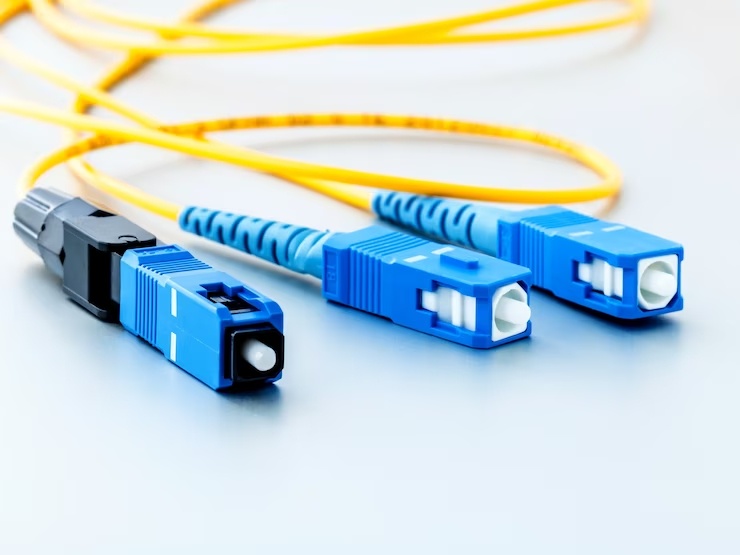When it comes to fiber connectors, it's easy to feel overwhelmed by the various types and applications. That is why I am writing this guide together. I have gathered information from all over to help you grasp everything.
We'll go over all you need to know about fiber optic connectors in today's blog. After reading this essay, you will understand why fiber has been capable of replacing traditional copper-based internet installations.
What are Fiber Optic Connectors?
Fiber optic connectors are accurate coupling devices that are used to quickly join fiber optic cables, allowing for quick connection and disengagement than splicing. The connection mechanically connects the fiber cores, allowing light to flow and travel uninterrupted through the cable.
Fiber optic connectors are minimal insert loss, excellent insertion repeatability, high return loss, and extended lifespan.
Although manufacturers have introduced over 100 fiber connections, just a few are the most popular and widely utilized in the industry. Following that, we'll go through the various types of fiber optic connectors.
Types of Fiber Optic Connectors
Fiber connectors vary according to the kind of cable they connect. The most popular fiber connections are LC and SC. Since SC and LC connectors are so popular, many systems are designed to accept them. What are the various kinds of fiber connectors? Here are a few of them:
-
Lucent Connectors (LC)
LC connectors have the smallest ferrules, measuring 1 1/4 mm, or nearly half the size of an ST connector. They come within the small form factor group of terminations because of their tiny size. Multimode transceivers and single-mode cables work best with these connectors.
-
Standard Connectors (SC)
SC connections have a 2 1/2 mm ferrule that fits into place nicely. A push-and-pull action is used to secure the connector. These terminations offer excellent levels of performance, which, along with a price decrease since their inception, has contributed to their widespread use in a variety of applications.
-
ST Connectors
ST connectors are among the earliest forms of fiber cable connectors. ST connections have a 2 1/2 mm ferrule and connect the fibers in a bayonet style through an adapter. These ferrules feature a spring-load arrangement that can make installation difficult unless the pieces are precisely seated, however a keyed slot aids in aligning the ferrules for connection.
-
Ferrule Core (FC) Connectors
Before the introduction of LC and SC connectors, FC connectors were among the most common for usage with single-mode connections. The screw-in construction eliminates connection disruptions even when the cable is pulled or the system is used in places with a lot of movement. FC terminations, like ST and SC connections, require a 2 1/2 mm ferrule. Anybody can build a bridge between these connection types using a hybrid adapter.
-
Multi-Position Optical (MPO) Connectors
MTP cables are the commercial brand of MPO connectors.MTP and MPO connections are similar, with the exception that MTP is mostly used for high-performance purposes and MPO is used in more mechanical environments. These two connectors are commonly used to join ribbon cables with numerous fibers.
What Are the Uses of Fiber Optic Connectors?
Terminations have a variety of applications based on the type of fiber optic cable connector used. Fiber optics, for example, has uses in the following fields:
-
Internet and Local Area Networks (LANs)
Fiber optic connectors provide more bandwidth than traditional cable choices. Fiber optics are commonly used to give internet and LAN access across a facility. Fiber optic connectors perform particularly well across lengths of more than 90 meters and when handling gigabit-speed connectivity. Both LAN and high-speed internet employ multimode fiber optic cable.
-
Community Antenna TV (CATV)
As fiber optic connectors are more affordable across long distances with less loss and greater capacity than earlier technologies, community antenna TV frequently prefers using them to transmit signals. Also, each fiber transmitter and receiver pair may transport more voice and video signals.
-
Digital Telephone Service
Another system that benefits from the usage of fiber optic cable is telephony. Several digital telephone applications, like CATV, use single-mode fiber connections. Telephony is one of the most common applications for fiber optic cables in the commercial sector.
-
Military Networks
Military operations require a connection in some of the world's hardest places. Battlefields, naval ships, military bases, and planes all require a way to communicate. Interference, mobility, and tapping into communication links all pose dangers to the military. Fiber optic connectors overcome these problems.
-
Security Systems
Security systems frequently require reliable data transmission connections that can send video and audio on time. Fiber optic connectors for closed-circuit television (CCTV) provide several advantages. For starters, the two-way route of fiber optic cable enables an operator to alter the camera angle as necessary. The ability to operate the camera increases security by allowing for greater observation of suspected targets.
Also, fiber optic cable can be extended over large distances with low loss. As a result of fiber-optic linked CCTV, cities, airports, warehouses, factories, and other major facilities can be secured.
-
Lighting
One of the less-considered uses of fiber optic cables is the ability to convey light rather than data messages over long distances. As a result, fiber optic lighting can be used to enlighten heat-sensitive areas, difficult-to-reach areas, or situations where regular electric wiring could be dangerous.
Conclusion
Find out more about specialized fiber optic solutions for your company right now. Dintek can assist you in sorting through the many varieties of fiber optic connectors and their uses. Our connectors are compatible with any other brand of product. Furthermore, we are networking equipment suppliers who work with your requirements.


No comments yet